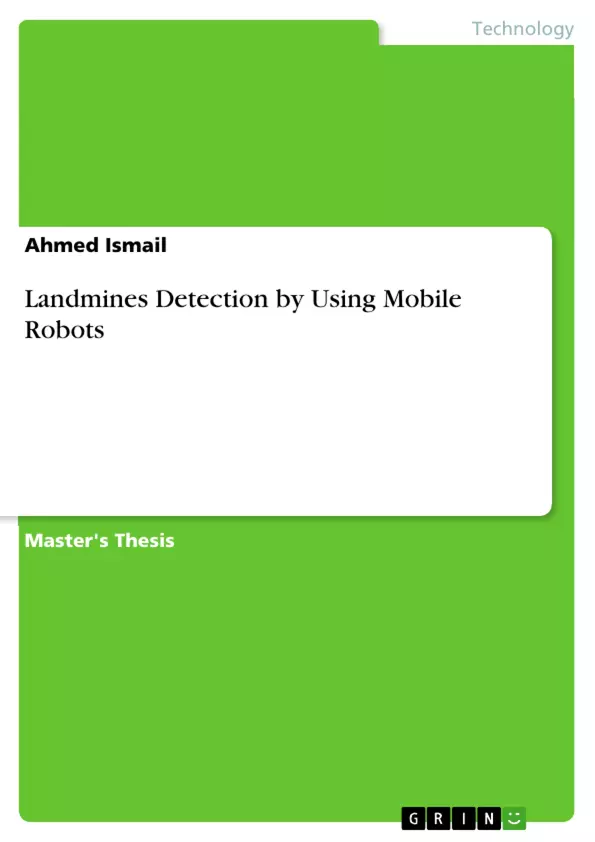This thesis studies strategies for humanitarian demining using robotic units. The author presents a low-cost system for landmines detection. The proposed system uses fusion of low cost multi sensors instead of using very expensive one. The proposed robot used sensor fusion technique to increase the probability of mine detection.
The author has developed decision level fusion to decrease false alarm of mines detection. He used complete coverage path planning to find all possible mines in the environment. The author proposed using multiple robots with the same structure to use complete coverage path in parallel way to save the time. He proposed effective obstacle avoidance algorithm to help the robot moves in autonomous motion. The proposed robot is light in order not to trigger mines and be destroyed. He proposed effective method to destroy mines where they are using arm on the robot to help defusing method.
The purpose of the thesis is to give an efficient solution for the landmines problem. By using robots that are capable of exploring and destroying buried landmines. The author also aimed to make the proposed robot with simle components to provide the soldiers and local landmines environments citizens with effective solution that they can use to save their lives.
Inhaltsverzeichnis (Table of Contents)
- Chapter 1: Introduction
- Landmines over the world
- Challenges
- Motivations
- Contributions
- Thesis Outline
- Chapter 2: Landmines detection strategies
- Landmines Detection Overview
- Classification of Mines
- Mine Detection Technologies
- Metal Detector
- Electromagnetic Methods
- Ground Penetrating Radar (GPR)
- Nuclear Quadruple Resonance (NQR)
- Electrical Impedance Tomography(EIT)
- Microwaves
- X-Ray Backscatter Method
- Infrared Method
- Sound and Ultrasound
- Neutron Method
- Acoustic/Seismic
- Biological Method
- Dogs and Rats
- Bees
- Bacteria
- Antibodies method
- Chemical Methods
- Mechanical Methods
- Probes and Prodders
- Mine Clearing Machines
- State of discussed solutions
- Developing a cost-effective landmine detection system using sensor fusion.
- Implementing decision-level fusion to reduce false alarms in mine detection.
- Designing a complete coverage path planning strategy for efficient mine detection.
- Exploring the use of multiple robots for parallel path planning to save time.
- Developing an obstacle avoidance algorithm for autonomous robot navigation.
Zielsetzung und Themenschwerpunkte (Objectives and Key Themes)
This thesis investigates the use of robotic units for humanitarian demining, presenting a low-cost system for landmine detection. The primary objective is to provide an efficient solution to the dangerous problem of landmines, using robots capable of exploring and destroying buried landmines. The proposed system aims to be user-friendly and accessible for soldiers and local communities affected by landmines.
Zusammenfassung der Kapitel (Chapter Summaries)
Chapter 1 introduces the problem of landmines worldwide, highlighting the challenges and motivations for developing effective detection and clearance solutions. It outlines the contributions of the thesis and provides an overview of its structure.
Chapter 2 provides a comprehensive overview of existing landmine detection strategies, including a classification of mines and a detailed examination of various technologies, such as metal detectors, electromagnetic methods, acoustic/seismic techniques, biological methods, and mechanical methods. The chapter concludes with a discussion of the state of the art in landmine detection solutions.
Schlüsselwörter (Keywords)
Landmines, humanitarian demining, robotic systems, sensor fusion, decision-level fusion, path planning, obstacle avoidance, mine detection, mine clearance, low-cost solutions.
- Citation du texte
- Ahmed Ismail (Auteur), 2016, Landmines Detection by Using Mobile Robots, Munich, GRIN Verlag, https://www.grin.com/document/373194



